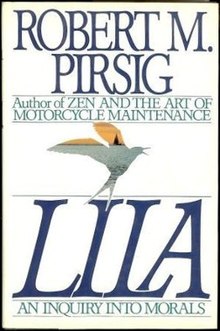Lila: An Inquiry Into Morals

First edition
|
|
| Author | Robert M. Pirsig |
|---|---|
| Country | United States |
| Language | English |
| Genre | Philosophical novel |
| Publisher | Bantam Books |
|
Publication date
|
1991 (revised edition published 2006) |
| Media type | Print (Hardback & Paperback) |
| Pages | 409 pp |
| ISBN | (first edition, hardback) |
| OCLC | 23732047 |
| 813/.54 20 | |
| LC Class | PS3566.I66 L54 1991 |
| Preceded by | Zen and the Art of Motorcycle Maintenance: An Inquiry into Values |
Lila: An Inquiry into Morals (1991) is the second philosophical novel by Robert M. Pirsig, who is best known for Zen and the Art of Motorcycle Maintenance. Lila: An Inquiry into Morals was a nominated finalist for the Pulitzer Prize for Fiction in 1992. This semi-autobiographical story takes place in the autumn as the author sails his boat down the Hudson River. Phaedrus, the author's alter ego, is jarred out of his solitary routine by an encounter with Lila, a straightforward but troubled woman who is nearing a mental breakdown.
The main goal of this book is to develop a complete metaphysical system based on the idea of Quality introduced in his first book. As in his previous book, the narrative is embedded between rounds of philosophical discussion. Unlike his previous book, in which he creates a dichotomy between Classical and Romantic Quality, this book centers on the division of Quality into the Static and the Dynamic. According to the novel, the known universe can be divided into four Static values: inorganic, biological, social, and intellectual. Everything in the known universe can be categorized into one of these four categories, except Dynamic Quality. Because Dynamic Quality is indefinable, the novel discusses the interactions between the four Static values and the Static values themselves.
Another goal of this book is to critique the field of anthropology. Pirsig claims traditional objectivity renders the field ineffective. He then turns his concept of Quality toward an explanation of the difficulties Western society has had in understanding the values and perspectives of American Indians. One interesting conclusion is that modern American culture is the result of a melding of Native American and European values.
...
Wikipedia
